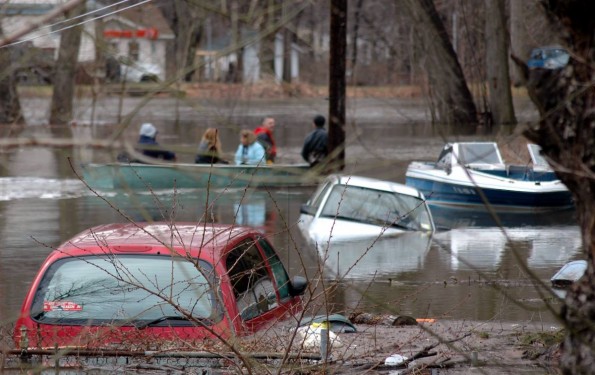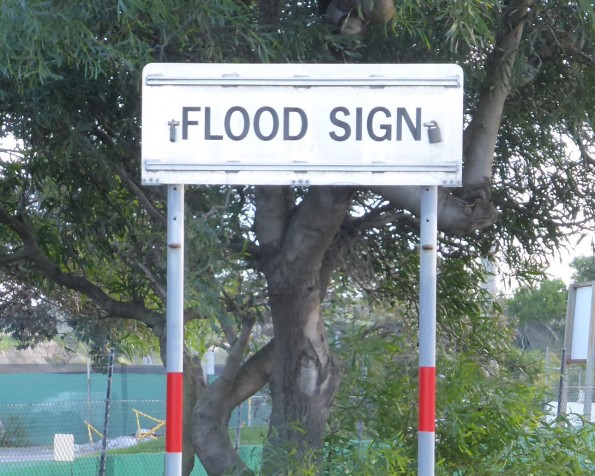
Flash floods are possible at any time. Some areas are particularly prone to them and you will see signposts, such as the one below, mounted on high poles.

At the edge of a flood you will have standing water several inches deep and this creates a risk of aquaplaning. If you hit deep water at speed you could first aquaplane, but as the vehicle sinks into the deep water it will be rapidly slowed due to the resistance of the water itself. The speed can force water into the engine, even if the intake is above the level of the water, and it can short out the electrics. Water doesn’t compress so if it gets into the cylinders it can bend or break a con rod.
Unless you have an SUV or ute with high suspension it’s advisable not to enter water more than 4-5 inches (10-13cm) deep. At 6 inches, water will reach the bottom of many passenger cars. At around 12 inches or 30cm of water cars start to float which reduces the grip of the tyres – fast flowing water can move a car at this depth. At 24 inches or around 60cm of water, you vehicle can be easily swept away if the water is moving.
If you are stranded you must get out of your vehicle and make it to safety. Water that is waist deep and flowing at more than 7kph will sweep everyone off their feet; if this is the case, stay in your car and call for emergency help unless the waters are rising so fast you are in even more danger.
Before you cross a flooded section of road
Watch another vehicle traverse the section and make a note of how deep it is. If it reaches the bottom of the vehicle, it’s best to avoid trying it.
Walk through the flood and measure the depth with a stick or other more reliable gauge.
Check that there is actually road beneath the flood and that it hasn’t been washed away.
If you can’t tell how deep the flood is, and if the water is moving fast, stay out of it. This motorcyclist lost his bike in fast-flowing water.
If you are sure that the water is not too deep then approach the flood at less than 5kph, keeping the revs high so that water finds it more difficult to get into the exhaust.
Maintain a consistent speed – don’t speed through a flood as it causes a bow wave which can swamp other vehicles, pedestrians or properties.
Roads are higher in the middle (the ‘crown’), so negotiate a flooded road by driving in the middle of the road.
Let one vehicle pass at a time. You will avoid a bow wave from a vehicle coming towards you, and if the vehicle you are following breaks down you won’t be trapped behind it.
If your car does start to float, open the door slightly to let water in; this will add weight to the car and will stop it floating.
After driving through, dry your brakes by applying them and driving forward slowly.
Vehicles designed to deal with floods
Some emergency vehicles are designed to drive through deep flood water. They have air intakes mounted high up, and will have the power and ground clearance to make it through.
